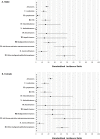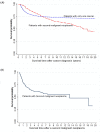Second malignant neoplasms after childhood cancer: A nationwide population-based study in Korea
- PMID: 30440007
- PMCID: PMC6237355
- DOI: 10.1371/journal.pone.0207243
Second malignant neoplasms after childhood cancer: A nationwide population-based study in Korea
Abstract
Background: Second malignant neoplasm is one of the most devastating late effects of childhood cancers. This study aimed to evaluate the incidence and survival outcomes of patients developing second malignant neoplasms (SMNs) after surviving childhood cancer in Korea.
Methods: Medical data of childhood cancer patients diagnosed between 1993 and 2012 were obtained from the Korea Central Cancer Registry. The risk of developing SMNs was calculated using standardized incidence ratio (SIR), excess absolute risk (EAR), and cumulative risk. Kaplan-Meier survival curves were estimated, stratified by SMN status.
Results: A total of 28,405 childhood cancer patients were diagnosed in the study period, and 337 (1.2%) developed SMN. The total follow-up period was 197,359 person-years at risk (PYR), with a median follow-up duration of 5.6 years. Overall SIR was 20.0, which was 23.2 in women, and 17.6 in men. The overall EAR was 16.4 per 10,000 PYR. The most common types of SMNs, in order of incidence, were other malignant epithelial neoplasms, leukemia, and soft tissue sarcomas. The cumulative incidence of developing SMNs was 0.7% at 5 years, 1.2% at 10 years, and 2% at 15 years. After primary cancer diagnosis, the 10-year overall survival rate of patients with SMNs was 65.1%, which was lower than the 73.4% in patients without SMN. After SMN diagnosis, the 10-year overall survival rate was 55.8%.
Conclusion: Through this registry-based study of 5.6 years of follow up, childhood cancer survivors were found to be at 20-fold higher risk of developing a malignant neoplasm compared to the general population. The majority of malignant neoplasms are malignant epithelial neoplasms, leukemia, and soft tissue sarcomas. Continued surveillance for assessing long-term risks, and guidance for appropriate long-term follow up of childhood cancer survivors, are needed.
Conflict of interest statement
The authors have declared that no competing interests exist.
Figures



Similar articles
-
Long-Term Risk of Subsequent Malignant Neoplasms After Treatment of Childhood Cancer in the DCOG LATER Study Cohort: Role of Chemotherapy.J Clin Oncol. 2017 Jul 10;35(20):2288-2298. doi: 10.1200/JCO.2016.71.6902. Epub 2017 May 22. J Clin Oncol. 2017. PMID: 28530852
-
Long-Term Risk of Subsequent Neoplasms in 5-Year Survivors of Childhood Neuroblastoma: A Dutch Childhood Cancer Survivor Study-LATER 3 Study.J Clin Oncol. 2025 Jan 10;43(2):154-166. doi: 10.1200/JCO.23.01430. Epub 2024 Oct 2. J Clin Oncol. 2025. PMID: 39356982
-
Second malignant neoplasms after childhood non-central nervous system embryonal tumours in North America: A population-based study.Eur J Cancer. 2017 Oct;84:173-183. doi: 10.1016/j.ejca.2017.06.035. Epub 2017 Aug 17. Eur J Cancer. 2017. PMID: 28822326
-
Second neoplasms in survivors of childhood cancer: findings from the Childhood Cancer Survivor Study cohort.J Clin Oncol. 2009 May 10;27(14):2356-62. doi: 10.1200/JCO.2008.21.1920. Epub 2009 Mar 2. J Clin Oncol. 2009. PMID: 19255307 Free PMC article. Review.
-
Secondary malignant neoplasms in testicular cancer survivors.Urol Oncol. 2015 Sep;33(9):392-8. doi: 10.1016/j.urolonc.2015.05.002. Epub 2015 Jun 11. Urol Oncol. 2015. PMID: 26072728 Review.
Cited by
-
Health Status in Long-Term Survivors of Hepatoblastoma.Cancers (Basel). 2019 Nov 11;11(11):1777. doi: 10.3390/cancers11111777. Cancers (Basel). 2019. PMID: 31718024 Free PMC article.
-
Risk of a second cancer in Canadians diagnosed with a first cancer in childhood or adolescence.EClinicalMedicine. 2019 Oct 23;16:107-120. doi: 10.1016/j.eclinm.2019.10.002. eCollection 2019 Nov. EClinicalMedicine. 2019. PMID: 31832625 Free PMC article.
-
Tandem High-Dose Chemotherapy Increases the Risk of Secondary Malignant Neoplasm in Pediatric Solid Tumors.Cancer Res Treat. 2024 Apr;56(2):642-651. doi: 10.4143/crt.2023.999. Epub 2023 Nov 24. Cancer Res Treat. 2024. PMID: 37997325 Free PMC article.
-
Second malignant neoplasms within 5 years from first primary diagnosis in pediatric oncology patients in Canada: a population-based retrospective cohort study.Front Oncol. 2024 Mar 28;14:1376652. doi: 10.3389/fonc.2024.1376652. eCollection 2024. Front Oncol. 2024. PMID: 38606094 Free PMC article.
-
Trends in Childhood Cancer in Kuwait: Data From the 2004-2017 Registry.Cureus. 2021 Feb 13;13(2):e13333. doi: 10.7759/cureus.13333. Cureus. 2021. PMID: 33643753 Free PMC article.
References
-
- Park HJ, Moon EK, Yoon JY, Oh CM, Jung KW, Park BK, et al. Incidence and Survival of Childhood Cancer in Korea. Cancer Res Treat. 2016;48(3):869–82. 10.4143/crt.2015.290 ; PubMed Central PMCID: PMCPMC4946351. - DOI - PMC - PubMed
-
- Pritchard-Jones K, Kaatsch P, Steliarova-Foucher E, Stiller CA, Coebergh JW. Cancer in children and adolescents in Europe: developments over 20 years and future challenges. Eur J Cancer. 2006;42(13):2183–90. 10.1016/j.ejca.2006.06.006 . - DOI - PubMed
-
- Morton LM, Onel K, Curtis RE, Hungate EA, Armstrong GT. The rising incidence of second cancers: patterns of occurrence and identification of risk factors for children and adults. Am Soc Clin Oncol Educ Book. 2014:e57–67. doi: 10.14694/EdBook_AM.2014.34.e57 . - DOI - PubMed
-
- Friedman DL, Whitton J, Leisenring W, Mertens AC, Hammond S, Stovall M, et al. Subsequent neoplasms in 5-year survivors of childhood cancer: the Childhood Cancer Survivor Study. J Natl Cancer Inst. 2010;102(14):1083–95. 10.1093/jnci/djq238 ; PubMed Central PMCID: PMCPMC2907408. - DOI - PMC - PubMed
-
- Hudson MM, Ness KK, Gurney JG, Mulrooney DA, Chemaitilly W, Krull KR, et al. Clinical ascertainment of health outcomes among adults treated for childhood cancer. JAMA. 2013;309(22):2371–81. 10.1001/jama.2013.6296 ; PubMed Central PMCID: PMCPMC3771083. - DOI - PMC - PubMed
Publication types
MeSH terms
LinkOut - more resources
Full Text Sources

